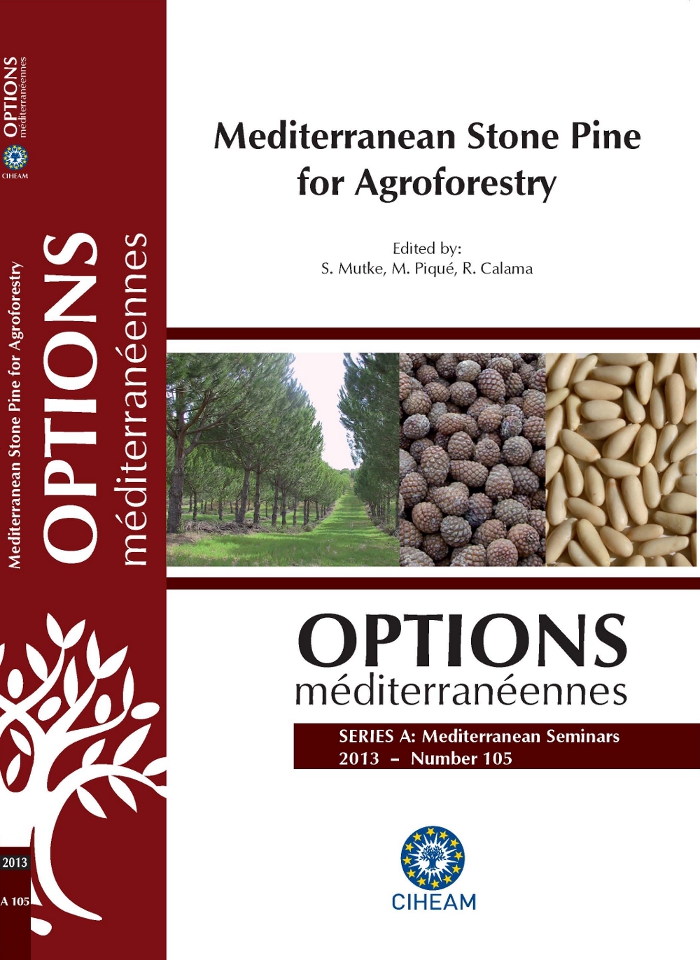| Article précédent | p. 81-88 | Article suivant |
Characterization of Pinus pinea L. and P. halepensis Mill. provenances from Spain and Tunisia related to their rootstock use
Experiences carried out on the last years for exploring the possibilities of stone pine as an orchard crop have rarely been focused in the study of rootstocks and their effect on phenology and cone production. Thus, on the framework of PCI project, rootstock behaviour trials of different P. pinea and P. halepensis provenances have been planned, including an early characterization under controlled conditions, complemented on the following years with a field trial network where these plant materials will be grafted and established on different edaphic and climatic conditions in Spain and Tunisia. In 2010, seedlings of 8 Spanish and Tunisian Stone pine (‘Remel’, ‘Mhibes’, ‘Aiguafreda’, ‘Caldes de Malavella’) and Aleppo pine (‘Kef’, ‘Thibar’, ‘Sallent’, ‘Palau-Sator’) provenances were submitted to 3 water stress levels and two substrate typologies in a split-split-plot experimental design carried out at IRTA’s station Torre Marimon (Caldes de Montbui, Spain). Data recorded included growth and biomass, physiologic parameters (RWC, CT, δ13C) and ontogenical information. Higher intra-specific variability and a more clear response to the different treatments have been observed in P. halepensis. Tunisian P. halepensis provenances showed higher biomass allocation in the more stressful conditions (particularly ‘Thibar’), but displayed significant reductions on allocated biomass in sandy substrate (particularly ‘Kef’); they also showed lower RWC values and a faster ontogeny (vegetative phase change).
Les expériences réalisées ces dernières années explorant les possibilités du pin pignon comme culture fruitière ont rarement été orientées à l’étude des porte-greffes et de leur influence sur la phénologie et la production de cônes. Ainsi, dans le cadre d’un projet PCI, des essais de caractérisation comme porte-greffes de différentes provenances de P. pinea et P. halepensis ont été planifiés, comprenant une évaluation précoce en conditions contrôlées, qui sera complémentée ultérieurement par un réseau d’essais de terrain où ces matériels végétaux seront greffés et établis sous différentes conditions édaphoclimatiques en Espagne et en Tunisie. En 2010, des plants de 8 provenances d’Espagne et de Tunisie de Pin pignon (‘Remel’, ‘Mhibes’, ‘Aiguafreda’, ‘Caldes de Malavella’) et de Pin d’Alep (‘Kef’, ‘Thibar’, ‘Sallent’, ‘Palau-Sator’) furent soumis à trois niveaux de stress hydrique et à deux typologies de substrats dans un dispositif expérimental en split-split-plot conduit à l’IRTA Torre Marimon (Caldes de Montbui, Espagne). Les données collectées incluent croissance et biomasse, paramètres physiologiques (RWC, CT, δ13C) et information concernant la différenciation ontologique. Une plus grande variabilité intra-spécifique et une plus claire réponse aux différents traitements ont été observées chez P. halepensis. Les provenances tunisiennes de P. halepensis (surtout ‘Thibar’) montrèrent une plus grande fixation de biomasse dans les conditions les plus stressantes, tandis que la biomasse fixée en substrat sableux fut significativement réduite (surtout pour ‘Kef’) ; elles montrèrent également des valeurs plus faibles de RWC et un changement plus rapide de phase végétative.
- [ Afficher ]
- [ Télécharger ]
- [ Exporter la citation ]
Vous pouvez télécharger la citation au format :
- [ Imprimer ]
-
Mots-clés
AGROFORESTERIE, ESPAGNE, ESSAI DE PROVENANCES, PHENOLOGIE, PINUS HALEPENSIS, PINUS PINEA, STRESS DU A LA SECHERESSE, SUBSTRAT DE CULTURE, TUNISIECiter cet article
Bono D., Othmani H., Ammari Y., Piqué M., Aletà N. Characterization of Pinus pinea L. and P. halepensis Mill. provenances from Spain and Tunisia related to their rootstock use. In : Mutke S. (ed.), Piqué M. (ed.), Calama R. (ed.). Mediterranean stone pine for agroforestry. Zaragoza : CIHEAM / FAO / INIA / IRTA / CESEFOR / CTFC, 2013. p. 81-88. (Options Méditerranéennes : Série A. Séminaires Méditerranéens; n. 105). AGROPINE 2011 International Meeting on Mediterranean Stone Pine for Agroforestery, 2011/11/17-19, Valladolid (Spain). http://om.ciheam.org/om/pdf/a105/00006785.pdf



